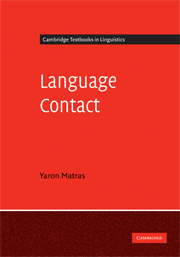Book contents
- Frontmatter
- Contents
- List of figures
- Preface
- List of abbreviations
- 1 Introduction
- 2 An emerging multilingual repertoire
- 3 Societal multilingualism
- 4 Acquiring and maintaining a bilingual repertoire
- 5 Crossing the boundaries: codeswitching in conversation
- 6 The replication of linguistic ‘matter’
- 7 Lexical borrowing
- 8 Grammatical and phonological borrowing
- 9 Converging structures: pattern replication
- 10 Contact languages
- 11 Outlook
- Notes
- References
- Author index
- Language index
- Subject index
9 - Converging structures: pattern replication
Published online by Cambridge University Press: 05 June 2012
- Frontmatter
- Contents
- List of figures
- Preface
- List of abbreviations
- 1 Introduction
- 2 An emerging multilingual repertoire
- 3 Societal multilingualism
- 4 Acquiring and maintaining a bilingual repertoire
- 5 Crossing the boundaries: codeswitching in conversation
- 6 The replication of linguistic ‘matter’
- 7 Lexical borrowing
- 8 Grammatical and phonological borrowing
- 9 Converging structures: pattern replication
- 10 Contact languages
- 11 Outlook
- Notes
- References
- Author index
- Language index
- Subject index
Summary
Defining pattern replication
Distinguishing matter and pattern replication
Models of bilingual speech production have tended to focus on the modes and conditions for selection of lemmas or word-forms from the lexicon (cf. Green 1998, Clyne 2003, Paradis 2004, Ijalba, Obler, and Chengappa 2004, Costa 2004, Kroll and Dussias 2004). Less attention is given to other aspects of language organisation, which we shall refer to as patterns or constructions (for the latter see Goldberg 1995, Croft 2001). We must assume that constructions also have a mental representation of some kind, that they are equally part of a ‘task schema’ that is assembled in order to pursue a communicative goal, and so that they are equally subject to the control of a selection and inhibition mechanism.
In Chapter 2 we noted the child's effort to comply with the selection of context-appropriate word-forms while at the same time allowing himself some flexibility in recruiting patterns from within his entire linguistic repertoire. While word-forms were in such instances subjected to tight selection and inhibition control, patterns and constructions appeared to be selected with the aim of maximising communicative efficiency. This suggests two possible paths, which are not incompatible with one another: the first is to select the construction which, due to its use on a routine basis, is most easily associated with the targeted task-schema; in other words, it is the construction that ‘comes to mind’ first.
- Type
- Chapter
- Information
- Language Contact , pp. 234 - 274Publisher: Cambridge University PressPrint publication year: 2009
- 1
- Cited by

